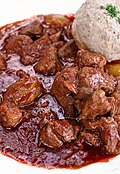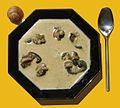| Name | Image | Type | Description |
|---|
| Asparagus Soup (Spargelsuppe) | | Soup | A creamy soup made from asparagus. |
| Beer soup [4] |  | Soup | In medieval Europe, it was served as a breakfast soup, [5] sometimes poured over bread. Pictured is beer cheese soup. |
| Brain soup [3] | | Soup | |
| Bread soup [3] |  | Soup | A simple soup that mainly consists of stale bread; variations exist in many countries, and it is often eaten during Lent. Bread soups are created with brown bread as well as with white bread. |
| Beansoup (Saarland Bohnesauf/Bippelches Bohnesupp) |  | Soup | Soup of beans, carrots, potatoes, onions and bacon |
| Borscht |  | Soup | A beetroot-based soup served with sour cream (schmand) and beef (originally from Ukraine) |
| Buttermilchsuppe | | Soup | Buttermilk soup with flour dumplings |
| Cheese soup [3] |  | Soup | All through the Middle Ages, soup prepared from cheese, eggs and pepper was commonly served in German monasteries. [3] Pictured is a cheese and potato soup. |
| Crawfish soup [3] | | Soup | |
| Eintopf |  | Soup | A simple vegetable soup; small meat balls are optional but common in it. |
| Fliederbeersuppe ( de ) |  | Dessert | A dessert soup made from elderberry, served with semolina dumplings |
| French onion soup [1] |  | Soup | A very common soup in German cuisine. [1] |
| Fruit soup [3] |  | Soup | Cherry soup (pictured) has been described as a seemingly popular soup in Germany. [3] |
| Goulash [1] |  | Soup or stew | Pictured is Bavarian Gulasch mit Semmelknödel which is often made with a mix of beef and pork. Here it is served with a Semmelknödel, a bread dumpling. |
| Grumbeersupp un Quetschekuche |  | Main course | Potato soup and plum tart |
| Hamburger Aalsuppe ( de ) (Hamburg Eel Soup) [6] |  | Soup | A sweet and sour soup of eel, meat broth, dried fruits, vegetables, and herbs. |
| Hochzeitssuppe (literally "wedding soup") |  | Soup | A spicy meat broth with bread dumplings, liver dumplings and finely sliced pancakes |
| Kartoffelsuppe |  | Soup or stew | A stew made with raw potatoes and other ingredients such as vegetables and sausages. |
| Kuttelsuppe ( de ) |  | Soup | A lightly bounded soup usually with acidified vinegar from tripe, regional spot or spots mentioned, which is common in variants in numerous countries. |
| Lentil soup |  | Soup | Prepared throughout the year in Germany, in part because the dry lentils store well. [2] |
| Milk soup [3] | | Soup | Consumed with semolina by Germans in the 1880s. [3] |
| Nudelsuppe [3] |  | Soup | Strong chicken stock and noodles [3] |
| Potato soup [2] |  | Soup | A common soup throughout Germany. [2] |
| Rumford's Soup |  | Soup | A simple soup prepared with barley or barley meal and dried peas as primary ingredients that was utilized in Munich and greater Bavaria to feed impoverished people. [7] |
| Schälklöße | | Soup | Consists of filled pasta and various vegetables. |
| Schwarzsauer [8] |  | Soup | A type of pork blood soup with various spices cooked in vinegar-water. [8] A sort of black pudding made with vinegar. The dish originated in eastern Prussia. [8] |
| Snail soup |  | Soup | Can be found in Baden cuisine. |




















